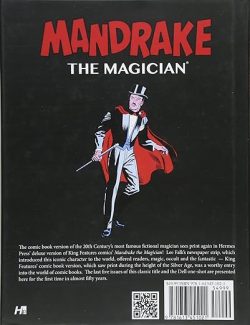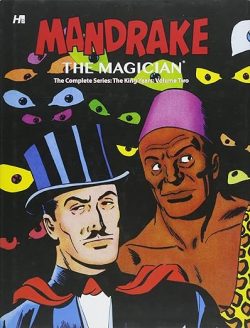

By Fred Fredericks, Gary Poole, Ray Bailey, Giovanni Fiorentini, Salvatore Stizza, Domenico Mirabella, Paul S. Newman & Stan Campbell & various (Hermes Press)
ISBN: 978-1613451021 (HB/Digital edition)
Win’s Christmas Gift Recommendation: Magical unrealism at its Finest… 9/10
Regarded by many as comics’ first superhero, Mandrake the Magician debuted as a daily newspaper strip on 11th June 1934 – although creator Lee Falk had first tried to sell the strip a decade previously. Initially drawing it too, Falk rapidly replaced himself, allowing the early wonderment to materialise through the effective understatement of sublime draughtsman Phil Davis. An instant hit, it was soon supplemented by a full-colour Sunday companion page from February 3rd 1935.
Falk – as a 19-year old college student – had sold Mandrake to King Features Syndicate years earlier, but asked the monolithic company to let him finish his studies before dedicating himself to it full time. Schooling done, the 23-year-old master raconteur settled into his life’s work: entertaining millions with astounding tales.
Falk – who also created the first costumed superhero in moodily magnificent generational manhunter The Phantom – spawned an entire comic book subgenre with his first creation. Most Golden Age publishers boasted at least one (but usually many) nattily attired wizards in their gaudily-garbed pantheons: all roaming the world(s) making miracles and crushing injustice with varying degrees of stage legerdemain or actual sorcery.
Characters such as Mr. Mystic, Ibis the Invincible, Sargon the Sorcerer, and an assortment of “…the Magician” ’s like Zatara, Zanzibar, Kardak ad infinitum all borrowed heavily and shamelessly from the uncanny exploits of the elegant, enigmatic man of mystery gracing the world’s newspapers and magazines.
In the Antipodes, Mandrake was a suave stalwart regular of Australian Women’s Weekly and became a cherished icon of adventure in the UK, Australia, Italy, Brazil, Germany, Spain, France, Turkey and across Scandinavia: a major star of page and screen, pervading every aspect of global consciousness.
As seen and described in Tim Lasiuta’s epically informative biographical and treat-packed ‘Introduction: Mandrake – a Magician for the Ages’, over the decades he’s manifested for radio, movies, chapter-serials, a theatrical play, television animation (as part of the cartoon series Defenders of the Earth) and so much more. With all that came a merchandising bonanza of games, toys (including magic trick kits), books, comics and the rest, much of it tantalizingly pictured here in posters, candid photos, book and comics covers plus a wealth of original art…
Falk worked on Mandrake and “The Ghost who Walks” until his death in 1999 (on his deathbed he was laying out one last story), but also found a few quiet moments to become a renowned playwright, theatre producer and impresario, as well as an inveterate world-traveller. However, he couldn’t keep up with the burgeoning demand, and depended a great deal on his later collaborator Fred Fredericks, who became an increasingly vital component of the process and ultimately Falk’s successor… which is where this collection comes in…
Between 1966 and 1967, King Features Syndicate dabbled with a comic book line of their biggest stars – Popeye, Flash Gordon, The Phantom and Mandrake – developed after the characters had enjoyed newsstand stardom under the broad and effective aegis of veteran licensed properties publisher Gold Key Comics. No stranger to funnybooks, Mandrake was featured in the David McKay Company’s Magic Comics (1939 to 1949 as reformatted strip reprints) and in new material in November 1956 he starred in Dell’s Four Color #752 and was also a major player for child-friendly Big Little Books.
This concluding full-colour archival volume gathers the pertinent parts of Mandrake the Magician #6-10, spanning September 1966 to May 1967, and includes in its entirety that historical bonus from FC #752 (November 1956). The wonder and mystery resume with a two-chapter saga from #6, cover-dated July 1967.
Scripted by Gary Poole and illustrated by Ray Bailey (the American one who worked on The Gumps, Terry and the Pirates, Steve Canyon, Turok, Son of Stone, Boris Karloff Tales of Mystery, U.N.D.E.R.S.E.A. Agent and more: not the British doyen of children’s comics who limned such juvenile delights as Milly and Billy and Kitty Hawke), ‘The Incredible Space Menace’ sees the master of mesmerism targeted by ousted and exiled alien tyrants who ride flying saucers hidden inside hurricanes.
One has been Mandrake’s close friend for 15 years, learning to counter his magic and turn it against the hero as a prelude to world conquest. Luckily, the mage has lifelong companion Lothar and beloved Princess Narda to save him before he can save humanity itself…
Those in the know are well aware that Mandrake was educated at the fabled College of Magic in Tibet, thereafter becoming a famous, globetrotting troubleshooter: always accompanied by his mighty African partner and loving companion (eventually – in 1997 – wife) Narda of Cockaigne. Together forever, they faced the uncanny, solved crimes and crushed evil.
His African associate took centre stage in #7 as ‘Jungle Drums’ provided the herculean warrior prince with a backstory and renewed purpose. In Mandrake’s American home Xanadu, Lothar is plagued by eerie, ethereal tom-tom beats calling him back to the “Dark Continent”. The episode gives Mandrake opportunity to explain that his friend is King of the Wambesi in voluntary exile, and how the magician had helped him expose the witchdoctor who poisoned the previous monarch to seize the throne. The case ended with Lothar choosing comradely adventure over luxury and comfort. Now a new menace threatens his people and demands ‘The Return of King Lothar’…
Both interlinked tales were by Poole & Bailey and conclude with the heroes back in Africa where the people have utterly forgotten their liege lord. After numerous lethally close shaves the culprits are exposed as western “doctors” whose inoculation program is designed to make the entire nation docile and compliant while the whites plunder the nation wholesale. Cue a little Mandrake magic and monarchical muscle…
Leaving another regent in charge, Lothar rejoins his world-travelling friend just in time to enjoy a little crime action that exploited some global franchising successes. In the 1960s and 1970s, Italian publisher Fratelli Spada produced their own original stories to augment the Falk material and King’s US Mandrake the Magician #8 (September 1967) was a translated version of ‘The Telltale Doll’, scripted by Giovanni Fiorentini and drawn by Salvatore Stizza. Here, the trio visit Mexico and become embroiled in a callous smuggling operation using children and their drug-stuffed toys as unsuspected, inadvertent couriers…
A month later another Italian tale by Fiorentini – illustrated by Domenico Mirabella and modified by script-doctor Poole – delivers cosmic horror as a body-possessing alien mutant runs amok on Earth. ‘The Terror From Outer Space’ is ruthlessly hunting a super-mineral able to eradicate the world and which is currently considered by ever-inquisitive Mandrake as a simple curio. He has no conception of the peril to him and the planet…
Poole & Bailey reunited for the final issue as #10 (November 1967) foreshadowed the coming horror story revival with a serious ghost story in ‘The Haunting of Hawk Inn’ as Narda takes a hard-earned vacation from action. Sadly, the rustic coastal hideaway she’s chosen comes with an arcane history and it’s not long before she’s begging Mandrake and Lothar to investigate a spectral raptor with a grudge and no mercy…
Behind an evocatively beautiful, sadly anonymous painted cover, the comics contents of November 1956’s Four Color #752 as published by Dell Comics add lasting lustre to this archive. The frontispiece ‘Mandrake’s Magic’ – explaining how his powers work – is part of the Introduction already described, so here are two full-colour complete exploits plotted by Falk and scripted by Paul S. Newman (The Lone Ranger, Turok, Dr. Solar, Man of the Atom) and Marshall McClintock, with art from veteran storyteller Stan Campbell (Lash LaRue, Tex Ritter, King of the Royal Mounted).
In ‘The Magic Maker’, our urbane Prince of Prestidigitation meets a gifted “player on the other side” as stage hypnotist Dr. Phantasmo is hired by a crooked candidate to wreck a crusading Mayor’s re-election campaign. With the troubleshooting trio strenuously objecting, the plot is bizarre and spectacular, but doomed to failure…
Then ‘Tide of Treachery’ sees a boating holiday in Canada draw the heroes into a dastardly scheme to sabotage and evict an entire fishing village. With murder and more in play, detective work reveals the truth about bucolic Bundy Bay and why property speculators Shain and Carven wants it so badly, but it’s Mandrake magic that settles the issue…
Ending the show is a fascinating look at the strip and comic book career of an artistic legend as Spike Barkin conducts a copiously illustrated and informative ‘Focus: Interview with Fred Fredericks’: exploring his incredible career, paying particular attention to the role of Lothar and how the Civil Rights movement of this period affected the look and actions of one of the most long-lived black characters in comics…
This thrilling tome offers exotic locales, thrilling action, spooky chills and pure fun in equal measure. The stories have lost none of their impact and only need you reading them. This a delicious, nostalgia-drenched triumph perfect for the Halloween season: straightforward, captivating action-adventure that has always been the staple of comics fiction. If that sounds like a good time to you, that’s Magic!
Mandrake the Magician® © 1956, 1966-1967 and 2016 King Features Syndicate, Inc.; Hearst Holdings, Inc. Reprinted with Permission. All rights reserved.
